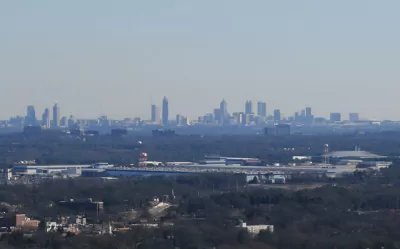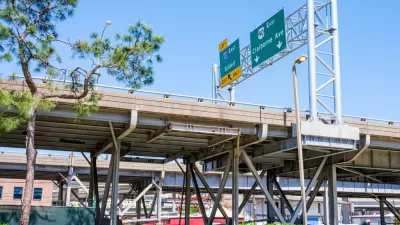The practice facility for a new Major League Soccer franchise was made possible by the demolition aging and affordable apartment buildings.

Joe Cortright writes: "For a couple of years now, we’ve been following the story of Marietta, Georgia, where local officials used $65 million in taxpayer funds to buy up and begin demolishing some 1,300 apartments along Franklin Road." A previous article by Cortright on the Marrietta case study explored the idea of suburban displacement. This time around, Cortright compares it to the poor example set by urban renewal practices of the mid-20th century.
The apartments are making way for a "verdant practice facility" to support a new Major League Soccer team, called the Alanta United. But as "hundreds of old but serviceable apartments were demolished to make way for these spacious fields," argues Cortright, the whole situation "is a striking case where the displacement of low income families was an explicit objective of public policy, rather than the side-effect of a changing real estate market."
If that all sounds familiar, that's because Marietta is taking a page from the same urban renewal playbook that many planners and urbanists consider a relic of the regrettable past. Cortright documents the changes in Marietta as the demolitions move forward along Franklin Road, which has now been renamed as Franklin Gateway, by sampling Google Street View images.
For the record, this isn't the first time that the words "urban renewal" have made an auspicious appearance in the urbanism news cycle. As Emily Badger noted in a New York Times article in December, President Donald Trump has used the words to describe his proposal for a "New Deal for Black America"—seemingly unaware of their fraught history and the discriminatory practices they connote.
FULL STORY: Suburban Renewal:

Maui's Vacation Rental Debate Turns Ugly
Verbal attacks, misinformation campaigns and fistfights plague a high-stakes debate to convert thousands of vacation rentals into long-term housing.

Planetizen Federal Action Tracker
A weekly monitor of how Trump’s orders and actions are impacting planners and planning in America.

San Francisco Suspends Traffic Calming Amidst Record Deaths
Citing “a challenging fiscal landscape,” the city will cease the program on the heels of 42 traffic deaths, including 24 pedestrians.

Defunct Pittsburgh Power Plant to Become Residential Tower
A decommissioned steam heat plant will be redeveloped into almost 100 affordable housing units.

Trump Prompts Restructuring of Transportation Research Board in “Unprecedented Overreach”
The TRB has eliminated more than half of its committees including those focused on climate, equity, and cities.

Amtrak Rolls Out New Orleans to Alabama “Mardi Gras” Train
The new service will operate morning and evening departures between Mobile and New Orleans.
Urban Design for Planners 1: Software Tools
This six-course series explores essential urban design concepts using open source software and equips planners with the tools they need to participate fully in the urban design process.
Planning for Universal Design
Learn the tools for implementing Universal Design in planning regulations.
Heyer Gruel & Associates PA
JM Goldson LLC
Custer County Colorado
City of Camden Redevelopment Agency
City of Astoria
Transportation Research & Education Center (TREC) at Portland State University
Jefferson Parish Government
Camden Redevelopment Agency
City of Claremont




























